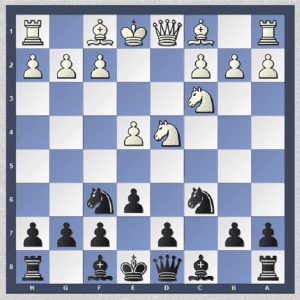
1.e4 c5 2.Nf3 e6 3.d4 cxd4 4.Nxd4 Nf6 5.Nc3 Nc6
Why to play it?
I advocated the Four Knights for the first time in blog post 34 and in many more posts afterwards. Here are the main arguments:
- Active piece play in general > For many players that’s more easy than typical Sicilian trench warfare
- Very combative > playing for three results
- Not well covered by mainstream theory > high surprise potential
- Many positions are difficult for the unprepared white player, many traps > opening advantage possible
- Flexibility regarding position type > Often you can choose between active piece play (initiated by Bb4/Bc5/d5) or a favorable form of the Scheveningen- or Paulsen-structure
- A lot of Negative Flexibility for the white player
What was the impetus for me to start analyzing it?
Actually, I already played the Four Knights in the 80s, for the same reasons as described above. However, back in the day, I couldn’t find a satisfactory answer to 6.Ndb5, and as I didn’t want to play the Shveshnikov, I turned to other openings instead.
In the early 2000s the line 6.Ndb5 Bc5 received some traction. However, it is still considered dubious to date as there is no mainstream coverage available (I offer 38 single analyses on this subject alone). In 2016 I had some ideas for improvements and managed to repair the critical lines. After the 6.Ndb5-problem was solved, I started to analyze all other variations.
What do you get?
The combination of the following features makes this material quite unique:
- The most important first. You receive ChessBase or pgn files. This format is an order of magnitude more effective for learning or game preparation than a book (see respective hyperlinks here).
- You save many days or weeks of working hours compared to transforming the analog information of an opening book to digital files on your computer.
- All reasonable White options on move 6 are covered. 16 moves in total (don’t worry, it is sufficient to learn the first 7, but its good to have the others available for reference purposes).
- 143 detailed sub-variations (single analyses).
- The equivalent of a 450-page book and the result of 8 accumulated months of work.
- I present it as a stand-alone weapon, recommending the underrated line 6.Ndb5 Bc5!?, where I made many important discoveries. Of course, it is also applicable in conjunction with the respectable Shveshnikov-Variation (the choice of Magnus Carlsen).
- Comprehensive coverage of the important line 6.Nxc6 (36 analyses).
- Complete Scheveningen Repertoire after 6.Be2 (31 analyses), consisting of robust and easy to handle variations (you simultaneously get an idea of the Deep Sicilian spirit).
- New ideas and novelties in every line.
- Comprehensive verbal comments (English), explanations of the underlying strategic concepts and the logic of the position (symbolic annotations cannot offer that, of course).
- Intelligent meta-level repertoire. All lines are carefully chosen to maximize your winning chances against weaker opposition.
- Explanations why alternatives were discarded.
- Redundancies, alternative options in many cases.
- Regular smaller updates every 6 months. These will contain my reaction to any question or suggestion by my clients.
- A complete update will occur in the 4th quarter of 2022, when all relevant new games will be included.
- Small distribution rate due to the low traffic status of my one-man website. Lines tend to remain secret weapons for a longer time.
- After sales service. If you think there are mistakes or something is missing, or if you simply need more verbal explanations in a particular line, I will update the material.
Examples
I posted two examples of my analyses in my blog. The first analysis is short, as I managed to confine the material to one single game. The second analysis is more on the longer side: Example 1, Example 2
How to work with the material?
The material is presented as a turnkey solution, providing you with a maximum of information. As every client has specific requirements, there is no one-fits-all advice on how to work with it. Generally, you receive the best result the more active your style of learning is. In case you are short of time, there are a lot of possibilities to reduce the effort:
1. The material is ordered by frequency. Concentrate on only the most frequent options for White (top 4 is the minimum, top 7 would be better).
2. Reduce redundancy. In some cases I present different options for Black. Play quickly through the main lines and stick to the option that suits you best.
3. Concentrate on the top level. Most analyses consist of three levels. If you only play through the main lines and disregard the side lines, you will safe a lot of time.
In any case, it is good to have all the material for reference purposes. If you happen to play blitz on a platform, you will be able to look up later, whether your interpretation was in line with my theory. You might even want to insert your games in the material, analyze it there and thus enrich the data.
Testimonial
Despite receiving a lot of positive reaction from my clients, I didn’t bother asking them for their permission to publish their remarks. The thing is, most people who order an opening analysis don’t want this to be public knowledge. After all, it is a fundamentally discrete topic. So, instead of molesting my clients, I just asked the most prominent one for a statement:
“The material is extraordinary with regard to extent and quality. I even started to implement the format of the database into my own work.” – GM Robert Hungaski
EUR 150